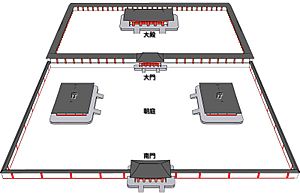Asuka, Yamato facts for kids
Asuka (飛鳥) was the Imperial capital of Japan during the Asuka period (538 – 710 AD). This important time in Japanese history is even named after this place! Today, Asuka is a village in Nara Prefecture.
What's in a Name?
Why was this place called Asuka? There are many ideas!
- Some people think it was named after a bird called the common crossbill, which is isuka in Japanese.
- Others believe the name came from words describing the land, like suka (meaning sandbar or delta) or asu (meaning crumbling land).
- It might also have been named after Asuka Nyorai, a special Buddhist figure. This figure is still honored at the Asuka-dera (Asuka Temple) and other old buildings from that time.
Discoveries from the Past

Archaeologists are still busy uncovering amazing things in Asuka. They have found many relics, which are old objects from the past.
- Recent discoveries include some of the oldest coins ever found in Japan, called Wado coins.
- They also found beautiful paintings inside ancient tombs called Kofun. These include the Kitora and Takamatsuzuka tombs.
- The Ishibutai Kofun is another famous tomb in Asuka. In 2004, archaeologists found the remains of a large house next to it. They think this house belonged to Soga no Umako, a powerful leader who might have been buried in the Ishibutai Kofun.
How to Get There
You can visit Asuka by train using the Kintetsu line. You can get off at either Okadera Station or Asuka Station. You can also drive there on Route 169.
Moving Palaces
During the Asuka period, the emperors and empresses didn't stay in one palace for long. They built new palaces for each ruler!
- When an emperor died, the whole court would move to a brand new palace. People believed it was bad luck to stay in a place where a dead ruler's spirit might still be.
- Sometimes, even during one ruler's time, palaces were changed. This happened if a palace was destroyed by fire or if something bad happened that people thought was a sign.
- These palaces were all made of wood, so none of them are still standing today. However, archaeologists have found things like stone bases for pillars, showing us where they once stood.
Some of the palaces built in Asuka include:
- Toyura Palace (593–603) during the reign of Empress Suiko.
- Oharida Palace (603–629), also during Empress Suiko's reign.
- Itabuki Palace (643–645) during the reign of Empress Kōgyoku.
- Kiyomihara Palace (672–694) during the reigns of Emperor Tenmu and Empress Jitō.
Asuka stopped being the capital when Empress Jitō and her court moved to Fujiwara-kyō.
See also
 In Spanish: Asuka-kyō para niños
In Spanish: Asuka-kyō para niños


